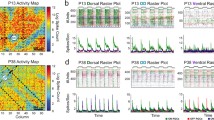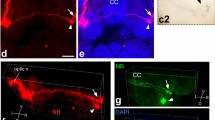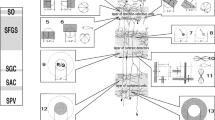Summary
-
1.
The responses of retinula cells and large monopolar cells (LMC's) to axial light flashes were recorded intracellularly in dark-adapted dragonflies (Figs. 1 and 4).
-
2.
LMC's respond to retinal illumination with a triphasic graded hyperpolarisation whose amplitude and waveform is intensity dependent. An initial hyperpolarising “on” transient is followed by a smaller amplitude sustained plateau. A rapid positive going “off” transient follows the cessation of the stimulus. Intensity is encoded as hyperpolarisation amplitude for action potentials are not recorded in these cells.
-
3.
Measurements of the difference between LMC and retinula response latency (2 msec, Fig. 6) and the LMC angular sensitivity (Fig. 7) confirm the previous anatomical studies suggesting that the LMC's are post-synaptic to retinula axons and receive their major input from axons with the same fields of view.
-
4.
Comparison of retinula and LMC response/intensity functions (Fig. 2) suggests that the visual signal is amplified when it is transferred from the retinula cell soma to a LMC.
-
5.
The derivation of average normalised response/intensity functions (Fig. 3) leads to an estimation of gain during the transfer of the LMC “on” transient and plateau amplitudes (Fig. 8). Their maximum values are times 14 and times 12, respectively.
-
6.
The possible mechanisms for producing amplification at this level in the visual system are discussed together with the significance of amplification in terms of the performance of the visual system.
-
7.
The synaptic noise level in the LMC's is high, from 4.2% to 15.6% of the maximum response amplitude with an average value of 8.6%. It is shown that this is equivalent to a receptor signal of 400 μV at threshold. It is proposed that the high noise level is the result of multiple synapses. It is shown that multiple synapses increase the visual signal: synaptic noise ratio in proportion to the square root of the number of synapses, in a manner analagous to a signal averager.
-
8.
It is concluded that the retinula-LMC pathway acts, in thedark-adapted state as a high sensitivity detection system, and shows several adaptations to maximise the signal:noise ratio.
Similar content being viewed by others
References
Arnett, D. W.: Spatial and temporal integration properties of units in the first optic ganglion of Dipterans. J. Neurophysiol.35, 429–444 (1972).
Autrum, H., Kolb, G.: Spektrale Empfindlichkeit einzelner Sehzellen der Aeschniden. Z. vergl. Physiol.60, 450–477 (1968).
Autrum, H., Kolb, G.: The dark adaptation in single visual cells of the compound eye ofAeschna cyanea. J. comp. Physiol.79, 213–232 (1972).
Autrum, H., Zettler, E., Järvilehto, M.: Postsynaptic potentials from a single monopolar neuron of the ganglion opticum I of the blowflyCalliphora. Z. vergl. Physiol.70, 414–424 (1970).
Cajal, S. R., Sánchez, D.: Contribucion al conocimiento de los centres nerviosos de los insectos. Parte I, retina y centros opticos. Trab. Lab., Invest. Biol. Univ. Madr.13, 1–164 (1915).
Chappell, R. L., Dowling, J. E.: Neural organisation of the median ocellus of the dragonfly. I. Intracellular electrical activity. J. gen. Physiol.60, 121–147 (1972).
Eccles, J. C., Ito, M., Szenthágothai, J.: The cerebellum as a neuronal machine. Berlin-Heidelberg-New York: Springer 1967.
Eguchi, E.: Fine structure and spectral sensitivities of retinula cells in the dorsal sector of compound eyes in the dragonflyAeschna. Z. vergl. Physiol.71, 201–218 (1971).
Gemperlein, R., Smola, U.: Transfer characteristics of the visual cell ofCalliphora erythrocephala. 3. Improvement of the signal-to-noise ratio by presynaptic summation in the lamina ganglionaris. J. comp. Physiol.79, 393–410 (1972).
Horridge, G. A.: Unit studies on the retina of dragonflies. Z. vergl. Physiol.62, 1–37 (1969).
Horridge, G. A., Meinertzhagen, I. A.: The exact neural projection of the visual fields upon the first and second ganglia of the insect eye. Z. vergl. Physiol.66, 369–378 (1970).
Hubbard, J. I., Llinás, R., Quastel, D. M. J.: Electrophysiological analysis of synaptic transmission. London: Arnold 1969.
Ioannides, A. C., Walcott, B.: Graded illumination potentials from the retinula cell axons in the bugLethocerus. Z. vergl. Physiol.71, 315–325 (1971).
Järvilehto, M., Zettler, E.: Micro-localisation of lamina located visual cell activities in the compound eye of the blowflyCalliphora. Z. vergl. Physiol.69, 134–138 (1970).
Järvilehto, M., Zettler, F.: Localised intracellular potentials from pre- and postsynaptic components in the external plexiform layer of an insect retina. Z. vergl. Physiol.75, 422–440 (1971).
Kaneko, A.: Physiological and morphological identification of horizontal, bipolar, and amacrine cells in goldfish. J. Physiol. (Lond.)207, 623–633 (1970).
Kirschfeld, K.: Discrete and graded receptor potentials in the compound eye of the flyMusca. In: The functional organisation of the compound eye, C. G. Bernhard, Ed., p. 291–307. Oxford: Pergamon Press 1966.
Knox, C. K.: Signal transmission in random spike trains with applications to the statocyst neurons of the lobster. Kybernetic7, 167–174 (1970).
Laughlin, S. B.: The function of the lamina ganglionaris. In: The compound eye and vision of insects, G. A. Horridge, Ed. Oxford: University Press 1973.
Laughlin, S. B., Horridge, G. A.: Angular sensitivity of the retinula cells of darkadapted worker bee. Z. vergl. Physiol.74, 329–335 (1971).
Scholes, J.: Discrete subthreshold potentials in the dimly lit insect eye. Nature (Lond.)202, 572–573 (1964).
Scholes, J.: The electrical responses of the retinal receptors and the lamina in the visual system of the flyMusca. Kybernetik6, 149–162 (1969).
Scholes, J., Reichardt, W.: The quantal content of optomotor stimuli and the electrical responses of receptors in the compound eye of the flyMusca. Kybernetik6, 74–80 (1969).
Shaw, S. R.: Organisation of the locust retina. Symp. Zool. soc. Lond.23, 135–163 (1968).
Shaw, S. R.: Decremental conduction of the visual signal in the barnacle lateral eye. J. Physiol. (Lond.)220, 145–175 (1972).
Smola, U., Gemperlein, R.: Transfer characteristics of the visual cell ofCalliphora erythrocephala. 2. Dependance on the location of measurement: retina-lamina ganglionaris. J. comp. Physiol.79, 363–392 (1972).
Strausfeld, N. J.: The organization of the insect visual system (light microscopy) I. Projections and arrangements of neurons in the lamina ganglionaris of Diptera. Z. Zellforsch.121, 377–441 (1971).
Trujillo-Cenóz, O.: Some aspects of the structural organization of the intermediate retina of Dipterans. J. Ultrastruct. Res.13, 1–33 (1965).
Werblin, F. S., Dowling, J. E.: Organization of the retina of the mudpuppy,Nectums maculosus. II. Intracellular recording. J. Neurophysiol.32, 339–355 (1969).
Zettler, F., Järvilehto, M.: Decrement-free conduction of graded potentials along the axon of a monopolar neuron. Z. vergl. Physiol.75, 402–421 (1971).
Zettler, F., Järvilehto, M.: Lateral inhibition in an insect eye. Z. vergl. Physiol.76, 233–244 (1972a).
Zettler, F., Järvilehto, M.: Intra-axonal visual responses from visual cells and second order neurons of an insect retina. In: Information processing in the visual systems of arthropods R. Wehner, Ed. Berlin-Heidelberg-New York: Springer 1972b.
Author information
Authors and Affiliations
Additional information
I am deeply indebted to Rainer Geppert who caught many of the dragonflies used in this study and whose knowledge of the local ecology ensured their constant supply. I am also grateful to Dave Cameron and Bob Fox and the staff of the Forest Research Institute, Darwin, for providing me with laboratory facilities there. I would like to thank my supervisors: Professor G. A. Horridge, for his encouragement and guidance, and Professor Randolf Menzel for many fruitful discussions arising out of the preparation of this paper. Finally I must thank Dr. R.B. Northrop who has made available to me his multiplicative model to explain anomalous acuity in locust and has verified the synaptic noise reduction model by providing a similar but more rigorous proof.
Rights and permissions
About this article
Cite this article
Laughlin, S.B. Neural integration in the first optic neuropile of dragonflies. J. Comp. Physiol. 84, 335–355 (1973). https://doi.org/10.1007/BF00696346
Received:
Issue Date:
DOI: https://doi.org/10.1007/BF00696346




